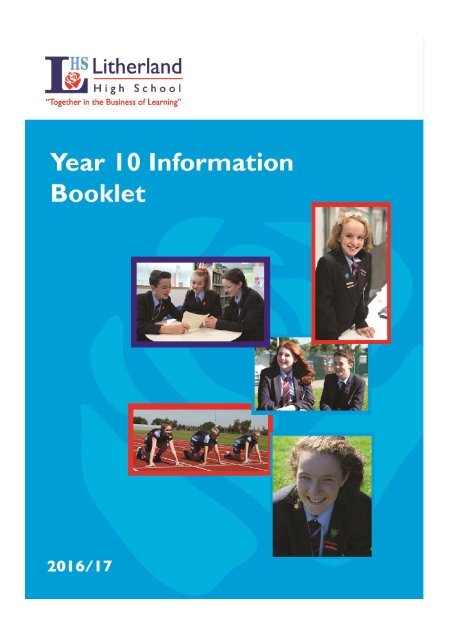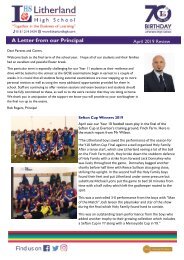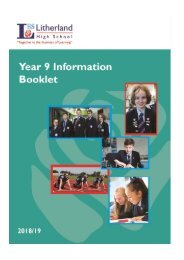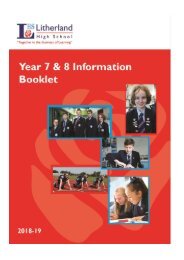LHS Year 10 Info Booklet
Create successful ePaper yourself
Turn your PDF publications into a flip-book with our unique Google optimized e-Paper software.
Contents<br />
Page 3 - Welcome from our Co-Principals<br />
Page 4 - <strong>Year</strong> <strong>10</strong> important dates<br />
Pages 5 - 7 - Teaching and Learning : Homework at <strong>LHS</strong><br />
: Marking & Assessment<br />
Pages 8 - <strong>10</strong> - Outcomes for Students : Progress<br />
Page 11 - Subject information<br />
Pages 12 - 14 - Student Support<br />
Pages 15 - 18 - Attendance and punctuality<br />
Page 19 - E safety<br />
Pages 20 - 25 - CEIAG (Careers Education, <strong>Info</strong>rmation, Advice & Guidance)<br />
Page 26 - Pupil Premium <strong>Info</strong>rmation<br />
2
Welcome<br />
from our Co-Principals<br />
Leading Litherland High is an honour and it is our privilege to welcome you to our parents<br />
information evening programme.<br />
The purpose of the event is to keep you informed of important aspects of school life as well as giving<br />
you the opportunity to help your son/daughter both academically and emotionally as a supportive<br />
parent/carer.<br />
By continuing to work in partnership we can maximise the potential of your son/daughter.<br />
Mr R Rogers /Ms M Sharratt<br />
3
Key Dates <strong>Year</strong> <strong>10</strong><br />
Event<br />
Date<br />
Interim report 1 sent home Week commencing 12th December 2016<br />
<strong>Year</strong> <strong>10</strong> Careers Workshop Friday 27th January 2017<br />
Interim report 2 sent home Wednesday 4 th January 2017<br />
Parents’ Evening Wednesday 26th April 2017<br />
<strong>Year</strong> <strong>10</strong> Mock Exam Week Mon 26th June — Friday 30th June 2017<br />
<strong>Year</strong> <strong>10</strong> Careers Week & Junior<br />
Leadership Applications Week<br />
Week commencing 3rd July 2017<br />
End of <strong>Year</strong> Reports sent home Week commencing <strong>10</strong>th July 2017<br />
<strong>Year</strong> <strong>10</strong> Celebration of Achievement<br />
Evening<br />
Wednesday 12th July 2017<br />
4
Teaching & Learning: Homework at <strong>LHS</strong><br />
Litherland High School uses the program ‘Show my Homework’. It allows staff to upload all homework<br />
quickly and easily. Students all have log in details and can access their homework tasks, completion dates<br />
and relevant resources from the website. It allows parents/carers the opportunity to support in their<br />
child’s learning and know what homework is being set.<br />
Rationale:<br />
Learning is a life-long process both inside and outside of school. We believe that homework provides<br />
invaluable opportunities for students to engage with their learning outside of the classroom environment.<br />
Homework aims to enhance the learning of students, assist their progress and allow for consolidation of<br />
their work. It promotes independence, time management and drives students to take an active role in<br />
their learning and in their progress.<br />
Aims:<br />
<br />
<br />
To encourage students to take more responsibility for their own learning.<br />
To promote self-reliance and self-confidence and encourage the habit of independent learning.<br />
To widen the learning experience by encouraging students to use materials and sources of information<br />
not available in the classroom.<br />
Allocated Homework Time:<br />
The purpose and value of homework activities are more important than the precise amount of time devoted<br />
to them. However, the time allocations indicated allow for meaningful tasks to be completed and is<br />
a reasonable time in line with national average.<br />
Key Stage 4 (<strong>Year</strong>s 9,<strong>10</strong> and 11)<br />
Please Note: Departments may choose to set weekly tasks, daily activities or projects for homework.<br />
Subject<br />
Mins Per Week<br />
Maths 60<br />
English 60<br />
Science 60<br />
Spanish 45<br />
RE 30<br />
Options 60<br />
5
Teaching & Learning: Marking and Assessment at <strong>LHS</strong><br />
The purpose and value of marking and assessment:<br />
<br />
<br />
<br />
<br />
<br />
<br />
<br />
To support Litherland High School’s drive for outstanding learning and teaching.<br />
To acknowledge the link between quality marking and excellent standards of attainment and<br />
achievement.<br />
To celebrate success.<br />
To support student progress and independent learning.<br />
To inform future planning, monitoring and appropriate intervention.<br />
To indicate to students and their parents/carers how well they are progressing towards their target<br />
and what they need to do to improve.<br />
To assist students when preparing for public examinations.<br />
Formative Assessment:<br />
Formative assessment is an integral part of teaching and learning. It does not contribute to the final mark<br />
given for the module; instead it contributes to learning through providing feedback. It should indicate what<br />
is good about a piece of work and why this is good; it should also indicate what is not so good and how<br />
the work could be improved. Effective formative feedback will affect what the student and the teacher do<br />
next.<br />
Summative Assessment:<br />
Summative assessment demonstrates the extent of a student's success in meeting the assessment criteria<br />
used to gauge the intended learning outcomes of a unit of work or programme of study and which<br />
contributes to the final mark given for the unit. It is normally, though not always, used at the end of a unit<br />
of teaching. Summative assessment is used to quantify achievement, to reward achievement and to<br />
provide purposeful data.<br />
High quality feedback consist of:<br />
<br />
<br />
<br />
<br />
Written feedback on written work.<br />
One to one conversations.<br />
Individual and whole class verbal feedback.<br />
Peer and self-assessment evaluations structured by teachers.<br />
All teachers at Litherland High School should provide feedback that:<br />
<br />
<br />
<br />
<br />
<br />
<br />
<br />
Is encouraging and constructive.<br />
Supports students in the ‘next steps’ of their progress.<br />
Is relevant to the learning objectives and success criteria.<br />
Is explicit.<br />
Makes comments directed as questions/ prompts to stimulate students to respond.<br />
Allows students sufficient time to act on feedback.<br />
Includes a balance of discussion and written comments.<br />
6
Response and Progression Time:<br />
Time must be built in to lessons and schemes of work to allow students to reflect and edit their work to<br />
help move forward in their learning. Comments given by teachers need to be precise, specific and<br />
appropriate to the student, subject and topic.<br />
Students will comment on their work in response to their teacher’s points and will do this in red pen.<br />
The time allocated can be at the beginning of the lesson, end of the lesson or set as a homework task but<br />
it must give students the opportunity to action the recommendations of the teacher.<br />
Verbal Feedback:<br />
It is expected that oral feedback is given to students on a regular basis. This can be shown in books by<br />
either the teacher comment or student response, however, it will sometimes be unnecessary to record<br />
this and should only be done when appropriate to do so. Verbal feedback can be done as a class or on a<br />
one to one basis and can be effective following a formative/summative assessment task. Whole class feedback<br />
can be useful to share good practice of the work and for students to identify examples of high quality<br />
work.
Outcome for students: Progress<br />
Changes to GCSE grading<br />
GCSE grades for English language, English literature and maths are changing in 2016. They will be reported<br />
as a number ranging from 9-1. A number of other subjects will be graded from 9-1 from 2017. This<br />
approach will mean:<br />
<br />
<br />
<br />
<br />
<br />
Broadly the same proportion of students will achieve a grade 4 and above as currently achieve a<br />
grade C and above.<br />
Broadly the same proportion of students will achieve a grade 7 and above as currently achieve an A<br />
and above<br />
For each examination, the top 20 per cent grades at 7 or above will get a grade 9 – the very highest<br />
performers<br />
The bottom of grade 1 will be aligned with the bottom of grade G<br />
Grade 5 will be positioned in the top third of the marks for a current Grade C and bottom third of<br />
the marks for a current Grade B. This will mean it will be of greater demand than the present grade<br />
C.<br />
8
Reporting to parents/carers<br />
Parents and carers will receive three monitoring reports during the academic year. The information contained<br />
within the report is shown below:<br />
Learning<br />
Profile<br />
5<br />
4<br />
3<br />
2<br />
1<br />
Description<br />
x is a self-motivated and co-operative learner who applies him/herself to<br />
the best of his/her ability at all times. S/He is willing to undertake additional<br />
work to support his/her learning and is determined to succeed.<br />
X is a self-motivated and co-operative learner who concentrates on making<br />
progress and achieving his/her learning goals.<br />
X is usually motivated to learn and is usually co-operative. S/He will remain<br />
on task with support but needs to take more responsibility for his/her<br />
learning.<br />
X has little motivation to learn. Tasks are frequently incomplete. S/He<br />
does not take responsibility for his/her progress.<br />
X lacks motivation to learn and appears unwilling to co-operate despite<br />
considerable teacher input. Progress is a significant cause for concern.<br />
Homework Description<br />
+<br />
Homework submission<br />
and standard are good.<br />
=<br />
Homework submission<br />
and/or standard are<br />
satisfactory. There are<br />
some areas for<br />
improvement.<br />
-<br />
Homework submission<br />
and/or standard are<br />
unsatisfactory.<br />
Significant improvement<br />
required.<br />
Subject<br />
Expected<br />
outcome:<br />
End of<br />
<strong>Year</strong><br />
Current<br />
Assessment<br />
Monitoring Point 1<br />
Learning<br />
Profile<br />
Maths 5 4+ 5 =<br />
English 5 5- 4 +<br />
Science 5 5- 4 +<br />
History 5 5+ 5 +<br />
Hmwk<br />
Expected outcome relates to the end of <strong>Year</strong> <strong>10</strong><br />
target grade for the subject. For most subjects<br />
including English, maths, science, geography, music,<br />
Spanish, art, computer science, history, P.E. and R.E.<br />
grades will range from 9-1. Business Studies and<br />
Design Technology will be graded from A*-G.<br />
Current assessment relates to current working<br />
grade. For most subjects, the grade will range<br />
from 9-1.<br />
+ Has a comprehensive understanding of the<br />
knowledge and skills required at the grade<br />
shown<br />
= Has a secure understanding of the knowledge<br />
and skills required at the grade shown<br />
- Is developing an understanding of the<br />
knowledge and skills required at the grade<br />
shown<br />
9
Parents’ Evenings<br />
There will a Parents’ Evening during the academic year. This event provides an important opportunity for<br />
you to discuss any issues or concerns relating to progress and to identify the next steps your son/<br />
daughter needs to take to maximise their achievement.<br />
Following each assessment point, the Progress Co-ordinator for <strong>Year</strong> <strong>10</strong>, Heads of Subject, Class<br />
Teachers and Senior Leadership Team review current progress and identify any interventions that may be<br />
required to support your child. If you would like to discuss your son or daughter’s progress at any time,<br />
please do not hesitate to contact the school.<br />
A new booking system has recently been implemented which enables parents and carers to book their<br />
appointments for Parents’ Evening on line. Parents and carers are welcome to contact the school to<br />
discuss progress at any time. To book an appointment go to https:/litherland.parentseveningsystem.co.uk/<br />
and fill in your child's details to access the system. (Please note, you will only be able to book appointments<br />
approximately 2 weeks prior to the evening, you will be informed when the appointments go live.)<br />
<strong>10</strong>
Subject <strong>Info</strong>rmation<br />
For more information about subjects visit our website at www.litherland-high.sefton.sch.uk. Click on the<br />
‘Curriculum’ menu and select ‘Subjects’. Each subject has a set of Quick View documents which are<br />
located on the right of each page.<br />
11
Student Support Service<br />
Litherland High is committed to ensuring consistency of professional practice in order to provide a secure,<br />
calm and productive learning environment. A student support team has been created to provide<br />
support for the personal development, behaviour and welfare of all students.<br />
The student support team aims to support students in the following areas :<br />
Progress<br />
Attendance & Punctuality<br />
Safeguarding<br />
Behaviour<br />
Anti-Bullying<br />
Mental Health & Wellbeing<br />
Counselling<br />
General support<br />
<strong>Year</strong> <strong>10</strong> Student Support Team<br />
Progress Co-ordinator<br />
Behaviour & Welfare Officer<br />
<strong>10</strong>L<br />
<strong>10</strong>I<br />
<strong>10</strong>T<br />
<strong>10</strong>H<br />
<strong>10</strong>E<br />
<strong>10</strong>R<br />
Leadership Link - Assistant Principal<br />
Assistant Principal<br />
Mr C Wilson<br />
Mr S Coleman<br />
Mrs Glover/Miss Loughlin<br />
Miss Houghton<br />
Mrs Walshe<br />
Mr Greene<br />
Mrs Hamer<br />
Miss Carlin<br />
Mrs K Campbell<br />
Ms C Murphy<br />
Behaviour & Welfare Team<br />
Behaviour & Welfare Officers work with students to remove barriers to learning and promote high<br />
standards of behaviour. By monitoring and tracking students, Behaviour & Welfare Officers provide early<br />
intervention to help improve behaviour and progress. They encourage students to value their education,<br />
rarely miss a day off school and be punctual to school and lessons. Safeguarding students is a priority,<br />
ensuring students are safe and feel safe at all times. Behaviour & Welfare Officers support students with<br />
their emotional and mental wellbeing and sign post to professional services when required.<br />
12
Uniform<br />
School regulations regarding uniform are as follows:<br />
Item Description Standard<br />
Navy blue blazer<br />
Official school badge<br />
Navy blue skirt/pinafore Regulation style No fashion skirts<br />
Dark grey trousers Tailored style Not jeans or canvas<br />
Light blue shirt/blouse Buttoned to the collar, short or long sleeved Must be tucked in<br />
Official clip-on tie<br />
School tie<br />
Blue for <strong>Year</strong>s 7-<strong>10</strong><br />
Red for <strong>Year</strong> 11<br />
Worn outside the shirt – not<br />
tucked in<br />
(Available from school)<br />
Navy blue jumper/cardigan V-necked Not zipped<br />
Socks/tights Navy, white socks or neutral, navy or black tights No patterned tights<br />
Black shoes<br />
Low heeled, plain black leather<br />
Boots (knee high or ankle)<br />
not allowed. No pumps or<br />
trainers. No logos.<br />
Hair<br />
Hair should be of an appropriate style for school. Extreme hairstyles are not acceptable.<br />
Make up<br />
Make up and nail varnish are not allowed. Students wearing make-up will be asked to remove it.<br />
Students wearing nail varnish or false nails will be asked to remove them.<br />
Jewellery<br />
One pair of small earrings may be worn. Earrings should be worn in the lobes of ears and not the top<br />
or middle sections. No other jewellery should be worn. No nose studs, tongue studs or facial<br />
piercings.<br />
Mobile Phones<br />
Students may bring mobile phones to school but they are to be kept out of sight throughout the entire<br />
day including when leaving the building. Any student using a mobile phone on the school premises will<br />
have it confiscated for the day. Parents/guardians will be asked to collect mobile phones should a<br />
student continue to use it in school hour detention after school that day.<br />
13
Student Support<br />
Ready to Learn Card<br />
To ensure standards of uniform are maintained, each student will carry a Ready to Learn Card. If uniform<br />
is being worn incorrectly or make up or jewellery worn, a member of staff will sign and date the card. If<br />
the card is signed three times, a detention will be arranged by the student’s Behaviour & Welfare Officer.<br />
Uniform Agreement Card<br />
If a student has a serious issue with uniform, such as the need for a new pair of shoes, the tutor or Behaviour<br />
& Welfare Officer will issue a ‘Uniform Agreement Card’. This card clearly states the issue and the<br />
date by which the matter will be expected to be resolved.<br />
Responsibility for Learning Room<br />
If a student chooses to disrupt the learning of others, not engage in learning or stops the teacher from<br />
teaching four times they will be withdrawn from the lesson. The student will be taken by a member of<br />
staff to the Responsibility for Learning Room and will stay there for the lesson they were withdrawn from<br />
and the following lesson (including break and lunchtime). The student will then complete a one hour detention<br />
after school that day.<br />
14
Promoting regular attendance:<br />
Helping to create a culture of engagement and success through good attendance is the responsibility of<br />
parents and carers, students and all members of school staff. Ensuring regular attendance at school is<br />
the legal responsibility of parents and carers. By law, all children of compulsory school age must attend<br />
school. Poor attendance not only undermines a child’s education and future life chances, it can also put<br />
children at risk and there is some evidence to suggest it can lead to anti-social behaviour.<br />
Parents and carers should:<br />
<br />
<br />
<br />
<br />
<br />
<br />
<br />
<br />
Familiarise themselves with the school’s Attendance Policy.<br />
Ensure their children attend school regularly and punctually.<br />
Contact school on the first and each subsequent day of absence.<br />
Provide a note if their child needs to leave school during the day for any reason which will be<br />
exchanged for an Exit Note.<br />
Contact school early where problems with attendance are emerging.<br />
Support the school in intervention and action plans, including attendance meetings as required.<br />
Participate in Attendance Panels/Parenting Contracts.<br />
Avoid taking holidays during term time.<br />
Students must:<br />
Attend registration and lessons punctually. Students are expected to be in class by 08.50.<br />
Meet or exceed the Government’s minimum individual attendance requirement of 95%.<br />
<br />
<br />
<br />
<br />
Provide a note of explanation to the school office from a parent/carer on the day of return after a<br />
period of absence.<br />
Participate fully when action plans are put in place.<br />
Collect an Exit Note from the Attendance Officers if they need to leave school during the day.<br />
Report to the school office if leaving (with an Exit Note) or arriving at any time during the school<br />
day.<br />
School will:<br />
<br />
<br />
<br />
<br />
<br />
<br />
<br />
<br />
Provide an education which prepares students for the opportunities, responsibilities and experiences<br />
of life.<br />
Promote a culture across the school which identifies the importance of regular and punctual attendance.<br />
Reward good or improving attendance.<br />
Make attendance and punctuality a priority for all students, parents and carers, teachers and governors.<br />
Promote and further develop positive and consistent communication between home and school.<br />
Operate a robust absence management system.<br />
Actively discourage holiday absence or extended leave of absence during term time.<br />
Operate a consistent approach to applications for leave of absence during term time, working<br />
within the Government guidelines and statutory targets.<br />
15
Attendance Stages Protocol<br />
Attendance Stage 1:<br />
If a student’s attendance is at 95% or below, it is identified as a ‘cause for concern’. Contact will be made<br />
with parents/carers and medical evidence will be required for all future absences.<br />
Attendance Stage 2:<br />
If, after two weeks, there is no improvement the student will be placed on an Attendance Report which<br />
will be monitored by the Tutor.<br />
Attendance Stage 3:<br />
If during this two week period there is not full attendance, the monitoring will be continued by the Senior<br />
Parent/Pupil Support Officer. There will be increased contact with home and the student will work<br />
with the SPPSO to address any issues which emerge.<br />
Attendance Stage 4:<br />
If after a further two weeks the student’s attendance has not improved, an Attendance Review will be<br />
held. The student, parents/carers and the Assistant Principal will be present at the Review. Individual<br />
barriers to learning will be discussed, targets set and support identified. The student will be placed on an<br />
Attendance Action Plan. The Attendance Officer will continue to undertake home visits. A student who<br />
has an attendance of 90% or below will be regarded as Persistently Absent and will move immediately to<br />
this or a higher Attendance Stage.<br />
Attendance Stage 5:<br />
If the Attendance Action Plan is unsuccessful in bringing about a significant improvement in the student’s<br />
attendance at school, a Fixed Penalty Notice may be issued. The Local Authority will become involved<br />
and will commence legal proceedings. The Fixed Penalty Notice is a fine of £60 to be paid within 21 days<br />
or £120 if paid up to 28 days after issue. If the fine is not paid after 28 days, Government guidelines stipulate<br />
that prosecution and a court appearance may follow.<br />
Attendance Stage 6:<br />
If a student’s attendance remains a cause for concern or if it has been at 90% or below for a significant<br />
period of time, the student and parents/carers will be asked to appear before the Governors’ Attendance<br />
Panel. Where Governors are concerned by a student’s level of absence, a Parenting Contract will<br />
be drawn up. The Parenting Contract will be signed by the student, parents/carers, the Co-Principal and<br />
a Safer Sefton Police Officer. It will clearly identify what is expected of the parents/carers in relation to<br />
the child’s absence and will clarify the support which will be provided by the school. It will operate for a<br />
fixed period of time.<br />
Attendance Stage 7:<br />
Where all efforts to ensure a young person’s right to an education have failed and where a parent/<br />
carer’s legal responsibilities are clearly not being met, it will be considered that the student may be at<br />
some degree of risk. In order to fulfil the school’s duty of care, a multi-professional Student Causing<br />
Concern Meeting will be held to review issues relating to safeguarding and to determine what steps<br />
need to be undertaken to ensure the well-being of the young person concerned.<br />
With regard to unauthorised absence, the school can request a Fixed Penalty Notice at any time in accordance<br />
with the Code of Conduct produced by Sefton Council.<br />
At any point in this process, a student may be moved to a higher or lower Attendance Stage<br />
should it seem appropriate or necessary to do so and particularly where concerns escalate<br />
rapidly.<br />
16
Attendance Stages Protocol<br />
AS1<br />
Attendance 95% or below is a CAUSE FOR<br />
CONCERN.<br />
AS2<br />
No improvement: ATTENDANCE REPORT.<br />
AS3<br />
No improvement: ATTENDANCE REPORT.<br />
(Senior Parent/Student Support Officer) Home<br />
Visits and Student Support.<br />
AS4<br />
No improvement or attendance at 90% or below:<br />
ATTENDANCE REVIEW<br />
ATTENDANCE ACTION PLAN<br />
HOME VISITS<br />
at 90% or below declared ‘PERSISTENTLY<br />
ABSENT’.<br />
AS5<br />
No improvement:<br />
LOCAL AUTHORITY INVOLVEMENT<br />
FIXED PENALTY NOTICE<br />
possible COURT APPEARANCE.<br />
AS6<br />
No improvement:<br />
GOVERNORS’ ATTENDANCE PANEL<br />
PARENTING CONTRACT.<br />
AS7<br />
No improvement:<br />
Multi-professional STUDENT CAUSING<br />
CONCERN MEETING.<br />
At any point in this process, a student can be moved to a higher or lower<br />
Attendance Stage should it seem appropriate or necessary to do so and particularly where concerns<br />
escalate rapidly.<br />
17
The Impact of Absence on Learning<br />
Days absent… Which is approximately<br />
weeks absent…<br />
95% <strong>10</strong> days 2 50<br />
Attendance during one<br />
school year…<br />
Which means this number<br />
of missed lessons…<br />
90% 20 days 4 <strong>10</strong>0<br />
85% 30 days 6 150<br />
80% 40 days 8 200<br />
75% 50 days <strong>10</strong> 250<br />
70% 60 days 12 300<br />
65% 70 days 14 350<br />
This chart shows that someone who is absent for <strong>10</strong>% of one school year will miss <strong>10</strong>0 lessons. Students<br />
at Litherland High School now begin Key Stage 4 in <strong>Year</strong> 9, so a person who missed <strong>10</strong>% each year would<br />
lose the learning from 300 lessons. A student with 85% attendance would lose 450 lessons.<br />
A great deal of research has been done on the impact attendance has on attainment. The latest figures are<br />
for the GCSE results of 2012-13 for research presented in October 2014. This shows that for students<br />
with less than 4% absence over the whole of Key Stage 4, 75% achieved five or more A*-C grades<br />
including English and Mathematics, for those absent 6-<strong>10</strong>% of the time the figure was 55% and it was 21%<br />
for those absent 20-30% of the time. For those who were only present for half their lessons, only 4%<br />
achieved five or more A*-C grades including English and Mathematics. Students with poor attendance are<br />
therefore almost certain to perform significantly less well in their exams than they would do otherwise.<br />
They are at a disadvantage compared to students who attend regularly, even if they would expect to do<br />
better based on performance at a younger age. In stark terms, those who attend more will get better<br />
qualifications and can expect to get better, higher paid jobs with all the benefits that that entails for their<br />
futures. In the case of genuine illness this is unavoidable, but where parents and carers have failed to<br />
ensure attendance at school, it is a matter which requires very clear and honest reflection and which<br />
demands action from the school and other organisations and agencies concerned with child welfare.<br />
18
E-Safety<br />
Mobile phones and computers are a source of fun, entertainment, communication and education.<br />
However, we know that some adults and young people will use these technologies to harm children. The<br />
harm might range from sending hurtful or abusive texts and emails, to enticing children to engage in<br />
sexually harmful conversations online, webcam filming, photography or face-to-face meetings. The<br />
school’s e-safety policy) explains how we try to keep students and staff safe in school. Cyber-bullying by<br />
students via texts and emails, will be treated as seriously as any other type of bullying and will be managed<br />
through our anti-bullying procedures.<br />
Chatrooms and social networking sites are the more obvious sources of inappropriate and harmful<br />
behaviour and students are not allowed to access these sites in school.<br />
If you would like any help or support with any aspects of E-safety the following websites offer excellent<br />
parental guidance.<br />
https://www.thinkuknow.co.uk/parents/<br />
http://www.nspcc.org.uk/help-and-advice/for-parents/keeping-your-child-safe/using-the-internet/internetsafety<br />
We would also like to draw your attention to the following videos which highlight some of the common<br />
risks facing our young people on a daily basis:<br />
https://www.thinkuknow.co.uk/parents/Secondary/Conversation-Starters/Go-to-the-movies/<br />
Consequences/<br />
https://www.thinkuknow.co.uk/parents/Secondary/Conversation-Starters/Go-to-the-movies/Exposed/<br />
https://www.thinkuknow.co.uk/parents/Secondary/Conversation-Starters/Go-to-the-movies/Matt-Thought<br />
-He-Knew/<br />
19
CEIAG: Post-16 Further Education and Training<br />
<strong>Info</strong>rmation for Students<br />
Raising participation legislation requires you to continue on in education or training until at least your<br />
18th birthday. Post-16 education and training providers vary so it is important to do some research and<br />
think about where you would like to attend. This will be discussed and explored in detail during your<br />
Careers Guidance interviews to support you to achieve a successful post 16 transition at the end of<br />
<strong>Year</strong> 11.<br />
Sixth Form<br />
Attached to a high school.<br />
Deliver level 3 courses only, these are normally A levels.<br />
College of Further Education<br />
Larger than a sixth form.<br />
Deliver a wide range of courses including diplomas and A levels.<br />
There are college courses for all levels of learners.<br />
Steps to applying<br />
At the start of year 11, you will be informed about 6th form and college open days. It is extremely useful<br />
to visit a number of different providers. You can take your parents, carers or friends with you.<br />
At the start of year 11, there will be presentations from local colleges and 6th forms in school.<br />
You will have accessed Careers Guidance interviews and drop ins to discuss and explore your individual<br />
pathway options.<br />
You will have attended a variety of events to inform you about different post-16 provision such as taster<br />
fairs and careers fairs.<br />
When you have decided which course/s you want to apply for, complete the application form (this may<br />
be on paper or based online). Deadlines vary but most should be completed by the end of January.<br />
Make sure you respond to invitations made by college or 6th forms. If you are asked to go to an interview,<br />
do your best to attend, or call to rearrange.<br />
20
What can I do next?<br />
After successful completion of a level 3 qualification, you could progress on to higher education and<br />
access a foundation or honours degree.<br />
Alternatively, you could progress on to a higher level apprenticeship or seek employment.<br />
Apprenticeships<br />
An apprenticeship is a job, with training, for which you will be paid a training wage.<br />
Apprenticeships last 1-4 years and you will spend time working with your employer and also studying at a<br />
college or training provider for work-related qualifications.<br />
There are three levels of apprenticeship<br />
Intermediate level apprenticeship – level 2 Advanced level apprenticeship – level 3 (equivalent to 2<br />
A level passes)<br />
<br />
Higher apprenticeships – Level 4 and above.<br />
What are the entry requirements?<br />
Some employers don’t ask for specific qualifications, but will expect you to have reasonable GCSE grades<br />
in English and Maths, and perhaps other subjects too. Employers will also expect you to be interested and<br />
keen to learn, so it is important that you ensure that an apprenticeship is for you. Applying for an<br />
apprenticeship can be competitive, so try and collect as much information as you can. If you have not<br />
achieved a minimum of a grade 4 in English and Maths you will be required to continue with these<br />
subjects as well as your work related qualification.<br />
What qualifications can I get?<br />
On an apprenticeship you will work toward work-based learning qualifications such as an NVQ level 2,<br />
functional skills and, in some cases, job-relevant qualifications such as a BTEC. The main qualification you<br />
will achieve is the apprenticeship Framework Certificate which will license you to practise or work in the<br />
trade you have learnt. All apprenticeships must include qualifications to show that you understand the<br />
industry and that you can do the job competently.<br />
21
What can I do next?<br />
From an apprenticeship you could go onto the advanced level apprenticeship. In the long term you could<br />
do a higher apprenticeship and may progress to a part time Foundation or Honours Degree.<br />
There are apprenticeships in different job areas such as:<br />
<br />
<br />
<br />
<br />
<br />
<br />
<br />
<br />
<br />
<br />
<br />
<br />
<br />
Accounts, Finance<br />
Business and Administration<br />
Childcare<br />
Construction<br />
Customer Service, Retailing and Wholesaling<br />
Engineering<br />
Hairdressing and Health and Beauty<br />
Hospitality and Catering<br />
IT<br />
Manufacturing<br />
Motor Vehicle<br />
Travel and Tourism<br />
Transportation<br />
Where can I find an apprenticeship?<br />
The National Apprenticeship Service is aimed at people looking for information and opportunities, so visit<br />
the website to find out more information and to search and apply for apprenticeship vacancies:<br />
www.appreticeships.org.uk. You will complete a CV which will enhance your application.<br />
All students who wish to access an apprenticeship must also apply to college or 6th form. To ensure that<br />
you have a guaranteed progression route in place. College and 6th forms applications are completed<br />
(generally) by the end of January whilst apprenticeships are not usually advertised until later in the year.<br />
Traineeships<br />
Traineeships are a new programme for young people who want to work, but who need extra help to gain<br />
a apprenticeship or job. Traineeships provide an opportunity to develop the skills and workplace<br />
experience that employers require. Traineeships are available for 16 – 23 year olds (up to 25 for young<br />
people with learning disabilities). Traineeships fit within broader study programmes for 16-19 year-olds.<br />
22
Careers/Job <strong>Info</strong>rmation<br />
To find essential information on the career/s you are interested in including:<br />
<br />
<br />
<br />
<br />
The work<br />
The hours<br />
Potential income<br />
Entry requirements<br />
New Kudos<br />
Kudos gives you careers suggestions based on your career likes and dislikes. Careerscape holds a<br />
database of job profiles and the subject links section provides you with information on the careers that<br />
are available to you based on your option choices.<br />
Look on: nationalcareersservice.direct.gov.uk (Go to: ‘Careers Advice’ – ‘Job Profiles’)<br />
Apprenticeships<br />
Register on the National Apprenticeship’s Service website to search and apply for local and national<br />
apprenticeship and training opportunities.<br />
www.apprenticeships.org.uk<br />
University<br />
The University Central Admissions Service<br />
All the information you need on going to university including entry requirements and a course search.<br />
www.ucas.com<br />
23
Local Colleges and Sixth Forms<br />
South Sefton Sixth Form - www.southsefton.com<br />
Sterrix Ln, Litherland, Liverpool L30 2DB - 01606 8<strong>10</strong>020<br />
Hugh Baird College -www.hughbaird.ac.uk<br />
Balliol Rd, Bootle, Liverpool L20 7EW - 0151 353 4444<br />
King George V -www.kgv.ac.uk<br />
Scarisbrick New Rd, Southport PR8 6LR - 01704 530601<br />
Southport College -www.southport-college.ac.uk<br />
Mornington Rd, Southport PR9 0TT - 01704 500606<br />
The City of Liverpool College - www.liv-coll.ac.uk<br />
Campuses on Myrtle Street, Bankfield Road, Clarence Street, Duke Street and Vauxhall Road. 0151 252 3000<br />
LIPA - www.lipa.ac.uk<br />
Mount St, Liverpool L1 9HF - 0151 330 3000<br />
St Helens College - www.sthelens.ac.uk<br />
Campuses: Town Centre Campus, Water Street, WA<strong>10</strong> 1PP – 01744 733766, Technology Centre Campus, Pocket Nock<br />
Street, WA9 1TT- 01744 623580<br />
Carmel College - www.carmel.ac.uk<br />
Prescot Road, St Helens, Merseyside WA<strong>10</strong> 3AG - 01744 452200<br />
24
Careers Education <strong>Info</strong>rmation Advice and<br />
Guidance (CEIAG)<br />
From 2013 all schools are required by law to deliver CEIAG to students from year 8 upwards.<br />
Litherland High takes its responsibility for impartial CEIAG seriously and has created a programme of<br />
CEIAG from the age of statutory obligation that is fit for purpose in the 21st Century work place to guide<br />
students to make the right choices for themselves. Each year group has a bespoke programme designed<br />
with information which is relevant to them, aims to be impartial and is broad and balanced allowing them<br />
to plot their ‘next steps’ journey with confidence.<br />
PSHCE<br />
A programme of CEIAG is in place in the PSHCE<br />
programme<br />
NEW KUDOS<br />
The one-stop-shop for planning successful futures<br />
where students explore their potential through a<br />
personalised experience based on their interests and<br />
aspirations<br />
COMMUNITY<br />
Students receive college, 6 th form and career advice<br />
including weekly impartial drop in sessions<br />
SENIOR<br />
LEADERS<br />
INTERVIEWS<br />
Each student will be seen by the Senior Leadership<br />
Team<br />
25
Pupil Premium: <strong>Info</strong>rmation for parents<br />
Introduced in 2011, the pupil premium is a sum of money given to schools each year by the Government<br />
to improve the attainment of disadvantaged children.<br />
This is based on research showing that children from low income families perform less well at school<br />
than their peers. Often, children who are entitled to pupil premium face challenges such as poor language<br />
and communication skills, less family support, lack of confidence and issues with attendance and punctuality.<br />
The pupil premium is intended to directly benefit the children who are eligible, helping to narrow the<br />
gap between them and their classmates.<br />
Schools are given a pupil premium for:<br />
Children who have qualified for free school meals at any point in the past six years. The school receives<br />
£935 for each of these children.<br />
Children who have been looked after under local authority care for more than one day. These children<br />
are awarded a premium of £1900.<br />
How do we spend pupil premium money at Litherland High School?<br />
Extra one-to-one or small-group support for children within the classroom.<br />
Employing extra teaching assistants to work with classes.<br />
Employing Progress Coordinators to raise achievement.<br />
Running catch-up sessions before or after school, for example for children who need extra help with<br />
mathematics or literacy.<br />
Running a school breakfast club to improve attendance.<br />
Funding educational trips and visits.<br />
Investing in resources that boost children’s learning.<br />
26

















